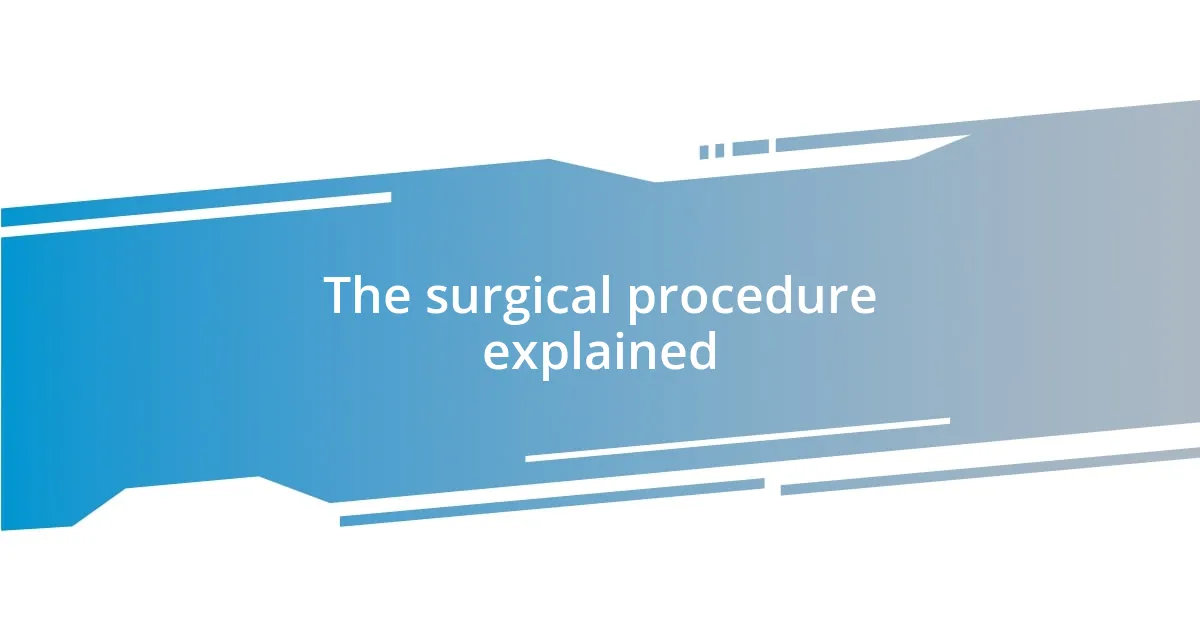Key takeaways:
- Living with epilepsy involves emotional challenges, stigma, and anxiety about seizures, requiring empathy and understanding from society.
- Surgical options for epilepsy vary, including resective and palliative surgeries, necessitating thorough evaluations and informed decision-making.
- Candidate selection for surgery relies on specific criteria, including seizure type, medication history, and overall health.
- The recovery process encompasses physical, emotional, and cognitive healing, highlighting the importance of support and celebrating small victories.

Understanding epilepsy and its impacts
Epilepsy isn’t just a medical condition; it profoundly affects every aspect of life. I remember a friend who, despite his vibrant personality and passion for painting, faced constant anxiety about when a seizure might strike. That fear can be paralyzing, often leading to social withdrawal or a loss of opportunities.
Living with epilepsy means navigating a world filled with uncertainties. It’s not just the seizures; it’s the stigma and misunderstanding from others that can hurt just as much. I often ponder, how can we shift perceptions and create a more supportive society for those affected? I believe sharing stories and fostering open conversations can bridge that gap and help others grasp the real challenges faced daily.
The emotional toll of epilepsy can be overwhelming. I once spoke with a young woman who described her journey as wearing a mask, trying to appear “normal” while grappling with the fear of having a seizure in public. It’s these hidden struggles that remind us empathy and understanding are essential, encouraging us to create a space where people can feel safe to share their experiences without judgment.

Exploring surgical options for epilepsy
Exploring surgical options for epilepsy can be a daunting yet hopeful journey. I recall meeting someone who, after years of trying various medications with limited success, was referred to a specialist about surgery. It was remarkable to see the mix of anxiety and eagerness in her eyes, as she weighed the possibility of finally gaining control over her seizures.
When considering surgical options, it’s essential to understand that not all surgeries are the same. For instance, I learned that resective surgery, which involves removing the seizure focus in the brain, can be quite effective for individuals with localized epilepsy. However, there are also palliative surgeries that aim to reduce seizure frequency rather than eliminate them entirely. I sat in on a consultation once, and the way the doctor explained each option made it feel manageable rather than overwhelming.
Ultimately, the decision involves a thorough evaluation, including brain imaging and possibly video EEG monitoring. I remember the patient mentioning feeling empowered by the collaborative approach with her medical team, which really highlights how critical informed decision-making is in exploring these surgical avenues.
| Surgical Type | Description |
|---|---|
| Resective Surgery | Removes the specific area of the brain causing seizures |
| Palliative Surgery | Aims to reduce seizure frequency without full removal |
| Multiple Subpial Transection | A technique that diminishes seizure activity by cutting the white matter |

Criteria for epilepsy surgery candidacy
Determining candidacy for epilepsy surgery involves several pivotal criteria. I recall a conversation with a neurosurgeon who emphasized the importance of comprehensive evaluation. He explained that before considering surgery, patients typically need to have tried at least two different anti-seizure medications without achieving satisfactory seizure control. This step is crucial, as it establishes a clear medical history and indicates that other treatment options have been exhausted.
Here are some key criteria for epilepsy surgery candidacy:
- Type of Epilepsy: The patient must have a specific type of epilepsy that is often focal (originating in one part of the brain).
- Seizure Frequency: Patients should have frequent seizures that significantly impact their quality of life.
- Medication History: At least two types of antiepileptic medications should have failed to control the seizures.
- Localization of Seizures: Imaging studies (like MRI) should reveal a well-defined area that can be surgically addressed.
- Overall Health: The patient must be in good overall health to withstand the surgery and its potential risks.
It’s also essential to consider psychosocial factors. I met a mother whose child had been evaluated for surgery, and she shared how the emotional readiness of both the patient and family plays a significant role in the decision-making process. That perspective really opened my eyes to how intertwined mental well-being is with the physical aspects of treatment. Surgery isn’t just about managing seizures; it’s about reclaiming life and hope, something I found profoundly moving during our discussion.

Pre-surgery evaluations and tests
Before surgery, comprehensive evaluations and tests are crucial for determining the best treatment pathway. I remember sitting in the waiting room of a neurology center, soaking in the palpable tension that filled the space. Each patient had their own story, with many undergoing a series of tests like MRI scans and video EEG monitoring to pinpoint the precise area in the brain where the seizures originate. It’s fascinating how these imaging techniques can paint such a detailed picture of the brain’s activity, guiding surgeons toward the optimal surgical approach.
One aspect that stood out to me was the importance of a multi-disciplinary team during the evaluation phase. I once observed a discussion where neurologists, neurosurgeons, and neuropsychologists collaborated to analyze test results. Their varied insights made me realize how vital it is to have different perspectives when considering surgery. Each specialist played a key role in assessing not just the seizures, but also the patient’s cognitive and emotional well-being. Have you ever thought about how the mind and brain work together in these intricate ways? It left me reflecting on how much our mental health impacts our overall treatment outcomes.
As I navigated conversations with patients preparing for surgery, the emotional weight of this phase became apparent. For instance, I spoke with a young woman who had a flood of questions and fears about the tests and what they would reveal. In those moments, I understood that pre-surgery evaluations are not just about gathering data but also about assisting patients in processing their emotions. Each scan and assessment carried the hope of a brighter future, which was both exhilarating and terrifying—an intricate dance of possibility and uncertainty.

The surgical procedure explained
When it comes to epilepsy surgery, the actual procedure can be as daunting as it is fascinating. Typically, I’ve learned that it involves a method known as resective surgery, where the surgeon removes the section of the brain responsible for the seizures. I recall visiting a surgical unit just before an operation, and the calm yet focused atmosphere was striking. It made me think about how the brain—though complex and mysterious—has a remarkable capacity for adaptation once a problematic area is removed.
The procedure often unfolds with the patient under anesthesia, and a neurosurgeon uses a combination of advanced imaging technology and their skilled hands to navigate the brain’s delicate structures. One memorable conversation I had with a surgical nurse revealed how they prepare both themselves and the patient for the incredible precision required during this phase. It’s not just about cutting; it’s about understanding the brain’s intricate wiring. Have you ever considered how every physical structure in our body comes with its own set of challenges? It makes the surgical process feel like an art form—one that balances science, experience, and a touch of intuition.
In some cases, patients may undergo a procedure called laser interstitial thermal therapy (LITT), which is less invasive. I remember discussing this with a patient who had opted for this technique, sharing how the idea of a smaller incision and quicker recovery appealed to him deeply. He described it as a “modern magic trick,” highlighting how technology has transformed our understanding of the brain and improved our approach to surgery. The excitement was palpable in his words, reminding me of how transformative solutions can emerge from the most challenging situations—a shared journey of hope and recovery that resonates deeply with many.

Recovery process after epilepsy surgery
The recovery process after epilepsy surgery can be as varied as the individuals who undergo it. I recall a family member’s journey post-surgery, where the initial days were a whirlwind of emotions. It was striking to witness the delicate balance between hope and apprehension as the medical team monitored her progress. How does one reconcile the excitement of potential seizure freedom with the reality of physical healing? This duality is something many patients face during recovery.
Initially, patients often experience fatigue and discomfort, which I found to be completely normal. I remember my friend, who had just undergone resective surgery, describing her struggle with simple tasks. It was eye-opening to hear her share that while every small step felt monumental, she was learning patience in a way she never thought possible. Recovery isn’t just physical; it’s also about embracing emotional and cognitive shifts. Have you ever considered how healing can encompass the mind as much as the body?
As weeks passed, the rhythm of healing began to settle. I witnessed my friend slowly reclaiming her energy and enthusiasm for life. Physical therapy and follow-up appointments became a staple of her routine, proving essential in regaining strength and confidence. It made me think about how recovery can often be a testament to resilience. I found myself reflecting on how each small victory can fuel the next step forward. How does one find gratitude in moments of difficulty? For her, it was celebrating tiny milestones, like taking a short walk, that marked the path to her new normal, reminding us all that healing is a journey built on persistence and hope.












